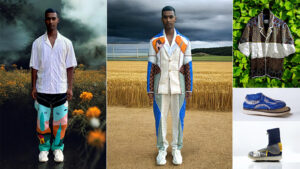His father sat for the Indian Administrative Service exam but did not clear the interview round yet hoped his son would achieve the feat. However, Pratyush Kumar did not want anything to do with bureaucracy. Skilled at fine arts, he never thought fashion design would be his calling.
Life has mysterious ways to steer us. His father, who worked in the Indian Forest service, ensured Pratyush’s upbringing was vibrant — from Gorakhpur to Uttaranchal, he travelled everywhere with the transferable job.
“I studied biology, physics, and chemistry in school, and thought one day I would be a heart surgeon,” laughs Pratyush (label Pieux). He won the Circular Design Challenge in 2022, an annual competition which recognises designers working with sustainable fashion, (he took home a cash prize of ?200,000).
His family has no remote connection with fashion and is dominated by government officers— the army, civil services or the judiciary. His brother, who supported him in this 3-year trek, is a mechanical engineer. “I was an oddball as I used to watch Hindi cinema and noticed only the costumes. I never read any fashion magazines and had no access to them growing up,” he laughs.
Now, after a three-month process, he is a finalist among eight others chosen from six Asian countries, for the inaugural 2025 edition of the Sustasia Fashion Prize, launched by sustainability leader Shaway Yeh.
They will work with alternative materials, from bio-based leather (Modern Meadow and Oleatex; plant fur BioFluff (Savian), organic silk (Otex), microbial dyed cashmere (Erdos), recycled wool (Woolmark). Their work will be displayed at the autumn-winter’ 25 schedule of the Shanghai Fashion Week. The winner takes home RMB 100,000 and, most importantly, a tie up with luxe retail outlets.
Interestingly, Pratyush realised medicine, and spending eight years studying more (he also faced several health challenges) wasn’t something he wanted to do. He joined Pearl Academy, pursued fashion design, was consumed by Alexander McQueen, even though he never knew how to stitch garments.

Modularity became his passion (he wanted to do his thesis on wearable technology). For his final project he travelled to Odisha, studied Tala Pattachitra pin-tip thin paintings etched on a string of palm leaves. He gave it a unique representation—folding garments which scored the highest in the graduating batch!
This won him the Department for Environment, Food and Rural Affairs (DEFRA) project with the Ministry of Textiles, London College of Fashion. For ten days he worked on how to explore sustainability in textiles with Nitin Bal Chauhan and Samant Chauhan.
“Science is my inspiration,” he smiles, “I work with micro-controllers in garments, so at certain intervals with coding you can switch lights in it. I also admire designers who play with thermo controllers reactive to heat, as well as photochromic which are sensitive to light, an ensemble becomes a playground of innovation,” he adds.
At one point he wanted to work with Nike and Adidas, sportswear brands, after completing his masters from De Montfort University, Leicester, UK, in fashion bodywear, corsetry and swimwear. The work visa rules changed in the UK, so he returned home, but his takeaway was he knew sustainability will be the future.
“Dad never said no, but wasn’t happy….no one had a positive outlook towards fashion, as I came from a conservative home,” he adds, There is a Japanese brand Anrealage Kunihiko Morinaga. It uses photochromic pigments to print their collection where UV light changes the colours. These pigments are UV sensitive and the mix of science and fashion fascinated him.
His inspirations have been many most notably—“Mirage”, where he distorts the blazer, gives it a glitch effect, placket melted, asymmetry, trousers are wavy. “Whenever I create there are multiple themes in my mind—pixels, playing cards, stamps, doodling, illusions. I go by what my heart tells me,” he explains.
Blazer comes with a corset panel, the zipper is added, once you open it, you can play with the length. Shorts can become playsuit, and add a peplum multiple options in one garment!
Most of his pieces are puzzles that use the interlocking system; cutting shapes (square to circular), a bit like the “shapes by chance”, which Issey Miyake offered in his Bao Bao bag.

Pratyush has explored modularity in eyewear too where you can replace missing parts, not discard the glasses, as well as footwear. “I named it Pieux, as Paris Fashion Week is on my bucket list,” he says, which translates to “pious” or “pure”. At one point he wanted to call it DIY since as a child he was fascinated by the Lego concept, where you can make anything depending on your imagination running wild.
Modular footwear, came from a fruit store, where he saw how the seller in Mumbai, cut the orange in spirals to juice it. So he went home and put on a masking tape on polythene.
Creating the first prototype of how we can change uppers of shoes depending on the occasion (Motorola Moto Z2 Force and Moto Z2 PlayThe Z2 Force and Z2 Play have magnetic pins on the back. You can connect to additional Moto Mod accessories, like boosting the battery, or adding a better camera, or turning it into a video projector).
Winning for Pratyush is not important, sustaining a business is. He was dogged by no sales, no buyers, no stores, to almost shutting down his business, he candidly explains.
“It’s frustrating as stores only want sequins and lehenga-cholis, which I consciously don’t want to make. But that is the real market in India.” Pratyush did work with costume designer Niharika Khan on “Roy” and “Fan” with Shah Rukh Khan but didn’t want to continue pursuing going green.
Fashion is a tough space to navigate —winning multiple awards does not guarantee longevity. In India what sells is being worn by Bollywood stars…you capture their followers, get orders. “You need sales to sustain a business long term,” he concludes. – Asmita is the Lifestyle Editor of NRI Focus. She is an award winning journalist who has been writing on fashion for the last 32 years


Leave a Reply